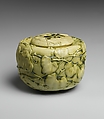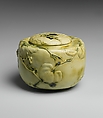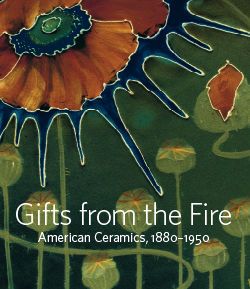Covered bowl with Boston ivy
Louis Comfort Tiffany (1848–1933) is renowned not only for his work in glass but also for his artistic endeavors in virtually every other medium. He embarked on experiments in ceramics shortly after he saw the avant-garde French ceramics at the Exposition Universelle in Paris in 1900. Tiffany debuted his pottery in 1904 at the Pan-American Exposition in Saint Louis, and the following year he sent two examples—a vase decorated with trumpet blossoms and this covered bowl—to the Salon of the Société des Artistes Français in Paris. Like most of Tiffany's work, the pottery from his furnaces relied heavily on nature for its inspiration. The leafy Virginia creeper vine that seems to grow up the sides and over the lid of the bowl also appears on his leaded-glass lampshades and windows. The glaze on the bowl is one of Tiffany's earliest. Called “Old Ivory,” it darkens when it pools in the interstices of the design, accentuating the sculptural relief. Like many other pieces of what Tiffany called his “Favrile Pottery,” this bowl relates to an enamel version, in this instance in the Chrysler Museum of Art in Norfolk, Virginia. Tiffany made several covered bowls in enamel, but this is the only known pottery example of the form.
Due to rights restrictions, this image cannot be enlarged, viewed at full screen, or downloaded.
This artwork is meant to be viewed from right to left. Scroll left to view more.






